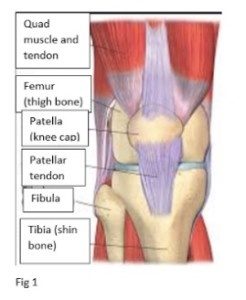PATELLAR FRACTURE
The patella (kneecap) is located in front of the knee, thereby serving as protection for the joint. Fractures can occur as a result of direct trauma to the front of the knee, and are typically seen in motor vehicle accidents and falls.
ANATOMY
The knee joint is made up of the ends of three bones, which are covered with a smooth surface called cartilage. These include the lower end of the femur (thigh bone), upper end of the tibia (shin bone) and back surface of the patella (kneecap). The patella connects the muscles from thigh to tibia (fig 1).
CLASSIFICATION
Patellar fractures are classified based on the pattern of fracture, and are referred to as stable, displaced, comminuted and open fractures. In a stable fracture, the broken ends of the patella are aligned and tend not to move, which allows for proper healing to occur. In a displaced patellar fracture, the ends are not aligned and therefore typically requires surgery. Comminuted fractures also require surgery as the kneecap fractures into multiple segments.
CAUSES
Usually caused by a fall, motor vehicle accident or indirect trauma because of sudden violent contraction of thigh muscles.
SYMPTOMS
In addition to pain, swelling and bruising, individuals with patellar fractures have difficulty walking and straightening the knee.
DIAGNOSIS
Your doctor will do a detailed physical exam, and if it’s a displaced fracture, the edge of fractured bone can be felt through the skin. X-ray is often the best way to visualize the fracture (fig 2).
TREATMENT
Your physician will determine the appropriate course of treatment based on the presentation of the injury and pattern of the fracture. For stable fractures, a cast or splint can be worn in conjunction with crutches to avoid bearing weight while the fracture heals.
Typically, when the segments of the fractured patella are displaced, surgery is necessary. The surgeon may use pins and screws to fix the segments into place.
Both surgical and non-surgical treatment should be followed by rehabilitation, in order to strengthen musculature and gradually increase weight placed on the knee once the bone has been healed.












